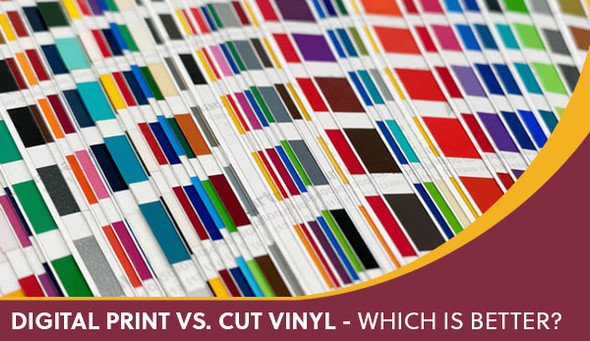I'm often asked by people what the difference between digital print graphics and cut vinyl graphics are. It can be a bit confusing for someone who doesn't know what these things are to suddenly see these specifications on their shop drawings, and it's very hard to approve something that you can't actually visualise.
So what's actually the difference between digital print graphics and cut vinyl graphics, and when should you use one over the other?
They're both actually two quite different things, and there's pros and cons to each. There's also scenarios where each one (or even possibly both) are suitable for use. In this article, we'll look at what each type of graphic is, what the benefits of each one are, and when you should be using them. There can be a vast difference in pricing between the various types of prints and cut vinyl decals, and you need to be able to understand these differences so you can compare your apples with other apples and not oranges.
Let's start with the one that most people would be familiar with.
Digital print graphics
Digital prints are used in a huge range of scenarios, from posters to banners and everything in between. In some cases they can be printed directly to your sign substrate, or they might be printed to a self adhesive print media (essentially a sticker) that is then applied to your sign, window, or wall.
Prints are great because you can replicate whatever you see on screen, whether it's a full colour photo or your company's logo. Anything that has multiple colours, especially those with gradients (the smooth transition from one colour to another) will need to be printed as cut vinyl cannot replicate gradients. If you have a pixel-based image file (for instance JPEGs or PNGs) this will need to be printed, as it is the wrong format for cut vinyl graphics. These are images where all of the detail is made up of lots and lots of little coloured dots, and if you zoom in close enough on your picture you'll be able to see those dots.
The amount of detail in a digital print depends on the DPI of your print file (the number of 'dots per inch' that form your picture), and the type of printer being used. If you're trying to print a massive 2 metre wide picture of your logo to go up on a building sign but your file is only 100mm wide, it's going to look absolutely awful and blurry because the image quality isn't high enough. Also, printers that are used on large format billboards and banners tend to be lower quality than intricate photo printers or printers for smaller-scale signage work as the viewing distance is different. If you're looking at a sign from 30m away, you need less resolution than something that you can get right up close to and be able to see every single little flaw. There are also certain colours that are difficult to replicate in inks, primarily shades of orange and green, and colours with a lot brightness and vibrancy to them.
To be able to print these colourful and photographic images, a digital print uses combinations of coloured inks to get the images on to the print substrate. Now, if you've ever walked past old milkbars with their decades-old advertising posters that have all faded to blue, you'll be familiar with the number one issue with prints; they fade. With modern printers and inks, this fading takes a lot longer than it used to but it still age over time. If your digital print is for permanent signage (not cheap temporary signs) it'll most likely be laminated to help protect it. This UV-stable clear layer of vinyl protects the inks so that they fade more slowly and also cannot be washed off when the cleaner comes around with a bottle of spray and wipe. On average you'll get a good 3-5 years out of most signage-grade prints, and 7 years + on prints that don't have full exposure to the afternoon sun. The more sunlight and weather exposure, the shorter the lifespan.
In summary, digital prints can:
- replicate photographic or full colour images and logos with gradients,
but:
- will fade over time.
Cut vinyl graphics
Cut vinyl graphics are something that less people are familiar with, but would have seen in passing more than they realise. These decals use self adhesive vinyl (or 'SAV') that have been cut to shape and adhered to your sign substrate.
Self adhesive vinyl is pre-coloured and therefore cannot be used for things that have gradients in them. Using a machine known as a vinyl cutter / plotter, you can run a file from the computer to tell the knife what shapes to cut from your coloured vinyl. If you want multiple colours, they have to be individually cut from different pieces of pre-coloured vinyl and then laid by hand colour by colour. These individual colours all have to be solid colours that you pick from a fan-deck of pre-coloured vinyls to best match the colours that you want. Some odd shades can be difficult to find, but the ranges available are quite vast and most companies find an acceptable match fairly easily.
The benefits of this type of graphic is that there's no fuzziness and no 'low quality' production. Each piece is knife cut and as perfect as the file that you supply. It's great for things like text on windows or statutory signs (like FIRE SAFETY DOOR signs) where you want perfectly clean text that will last for a long time. It's also the best thing to use for company logos that don't have gradients, as you're guaranteed to get a clean computer-cut finish on all the edges. The methods used to colour the vinyl is also a lot more UV stable than the inks that are used in a digital print, and they will keep their vibrancy for a much longer time. Many self adhesive coloured vinyls will actually shrink before they fade (again, based on the type and quality of the vinyl used). Most industry standard coloured self adhesive vinyl has a 7 or 8 year lifespan before they begin to fail, with higher end products at 10 years, and cheap ones at 5 years.
In order to cut these types of graphics, you need to have a vector file like an EPS or AI. Unlike the pixel-based images used in print graphics, these are mathematically defined by points and paths. Therefore, you can scale them up as large as you want, from 10mm to 10 metres, and you won't lose any quality whatsoever. These will need to be vectors that have been created in a program like Illustrator or Corel Draw or even some CAD programs, so that the correct file data is stored. Some people draw their files as pixel images in Photoshop then save them as vector formats and hope that this is adequate, but it's unfortunately not as the data simply isn't correct.
Apart from the inability to create photographic, full colour images with gradients, cut vinyl graphics only have a couple of drawbacks. First of all, because each piece is individually cut, it can sometimes lead to vandalism. Though it's not the easiest thing in the world to do, SAV can be picked off by vandals who think it's funny to remove letters leading to sometimes inappropriate words on your sign. The longer the SAV is applied for, the more difficult it is to remove and things like clear coats and pre-treatments can make it significantly harder, or almost impossible to remove.
The other drawback is that it's not easy to do it yourself if you've bought a cut vinyl decal and want to install it on your own. Unlike printed decals where you can just peel it off in one piece from the wax paper and stick it down, there's a little bit more to the install of cut vinyl decals. As these are all individually cut letters, they need to be applied in one piece through the use of 'application tape' - a sticky film that holds the vinyl together as one piece. There's a bit of a trick to it and if it's not done right you can get bubbles or dust underneath or even misaligned text.
In summary, cut vinyl decals:
- look amazing for text and graphics in solid colours and have a good lifespan,
but:
- can sometimes be easier to be vandalised, and should probably be professionally installed.
The good thing is that you can actually use a combination of both if you need to. Digitally printed vinyl can still be form cut (even though it is a thicker type of vinyl, especially with laminate applied to it), so if your logo has nice solid coloured text alongside a logomark with gradients in it, you can sometimes use cut vinyl for the text and print for the logomark. The Woolworths logo is a great example of this. On building signage, the 'Wapple' has gradients in it and is always specified to be printed, but the Woolworths text uses cut vinyl for longevity and edge clarity.
Price-wise, print tends to be significantly dearer too. The processes involved use more expensive equipment, higher-cost media and additional consumables too.
So there you have it! We've covered off the basic differences between digital print vinyl graphics and cut vinyl graphics. If you have more questions, feel free to contact us and we'd be happy to help discuss this with you.
Stay tuned for our next informative blog post where we discuss the differences between the types of print media available on the market!

